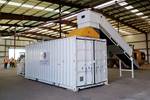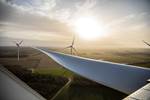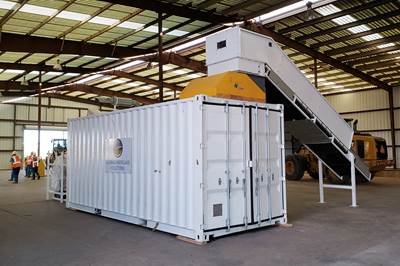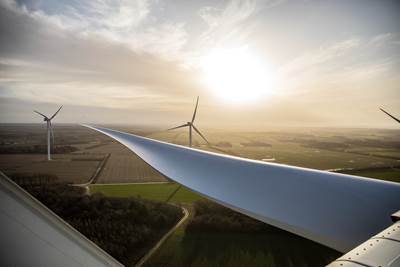TNO research offers circularity solution for discarded wind turbine blades
Thermochemical method involving pyrolysis extracts fibers, which can then be reprocessed as thermoplastic composites for various recyclable products.
A process cutting wind turbine blades in half. Photo Credit: TNO
The (TNO, The Hague, Netherlands), an independent research organization, is working in collaboration with Brightlands Materials Center (Geleen, Netherlands), an initiative of TNO and the Province of Limburg, which specializes in developing sustainable materials, to advance wind blade recycling initiatives.
With the rate at which wind energy is growing in Europe, TNO anticipates some 4 million tonnes of waste every year from offshore wind turbine blades at the end of their 25-year service life. “Not only do we need to get rid of the huge pile of turbine blades that are now being buried or incinerated, but governments are imposing increasingly stringent requirements on wind farm builders and owners,” Harald van der Mijle Meijer, senior consultant for Wind Energy Technology at TNO, says. “Companies bidding for tenders to build offshore wind farms in many countries must be able to demonstrate that the . Most components, such as the foundation and the tower, can already be recycled, but there’s no commercially attractive solution yet for the blades.”
Current wind blades are more than 50% glass and carbon fiber, which are in principle, suitable for reuse. Since mechanical or chemical recycling has drawbacks in regard to quality and scaling up, experts at TNO and Brightland Materials Center have focused on developing a thermochemical process involving pyrolysis, in which the material is heated to almost 500ºC without oxygen, releasing the fibers. They can then be processed into thermoplastic composites for use in recyclable products. The method, researchers note, ensures the best outcome for reusing the recycled material again and again.
“We work here with a group of researchers on the development and innovation of polymeric materials, in this case thermoplastic composites. These consist of plastic and fibers, which makes them extra strong,” TNO business development manager Richard Janssen says. Janssen works at Brightlands Materials Center. “You therefore see them in more products, from car parts to sporting goods. Wind turbine blades also consist of composites, but a different type: thermoset composites. They also contain fibers, but a different type of plastic that hardens during production and is very difficult to recycle. Pyrolysis is a solution to this problem, allowing the fibers to be recovered. We then use these fibers in the easier-to-recycle thermoplastic composites, making it simpler to take them apart after use.”
According to Mariusz Cieplik, senior scientist materials at TNO, specializing in pyrolysis, “This is an extension of a technology we developed previously to produce biochar, a soil improver that we make from biomass by means of pyrolysis. We’re now making that process suitable for recycling wind turbine blades. There are strong similarities between the two processes. In both cases, the aim is to separate fully what is released during pyrolysis from the solids that remain. The technology has since outgrown the lab. We now have a pilot plant that can make biochar on a scale of a few tonnes. And we’ve successfully replicated that process for turbine blade recycling.”
“We make this attractive to all the parties in the supply chain,” van der Mijle Meijer adds. “Manufacturers in various sectors, for example the automotive industry, are increasingly under legal obligations to use recycled materials in their products. And the wind energy industry has a waste problem. We bring those two worlds together. Our innovative process enables us to add value on two sides. The material we extract from the blades can be used in many high-value products, such as car parts, furniture, packaging, smartphones — too many to mention.”
In a few years’ time, TNO anticipates blade recycling to be carried out at a number of locations around the country, preferably near major ports where the blades are brought in from sea or land. Hubs will then be set up there to turn the discarded blades into high-quality semi-finished or finished products. TNO is discussing this at European level with industry, governments, and knowledge partners, with the aim of organizing it on a large scale.
Related Content
Composites end markets: Sports and recreation (2025)
The use of composite materials in high-performance sporting goods continues to grow, with new advancements including thermoplastic and sustainability-focused materials and automated processes.
Read MoreLife cycle assessment in the composites industry
As companies strive to meet zero-emissions goals, evaluating a product’s carbon footprint is vital. Life cycle assessment (LCA) is one tool composites industry OEMs and Tier suppliers are using to move toward sustainability targets.
Read MorePlant tour: Hexagon Purus, Kassel, Germany
Fully automated, Industry 4.0 line for hydrogen pressure vessels advances efficiency and versatility in small footprint for next-gen, sustainable composites production.
Read MoreASCEND program completion: Transforming the U.K.'s high-rate composites manufacturing capability
GKN Aerospace, McLaren Automotive and U.K. partners chart the final chapter of the 4-year, £39.6 million ASCEND program, which accomplished significant progress in high-rate production, Industry 4.0 and sustainable composites manufacturing.
Read MoreRead Next
Dustless, mobile solution for on-site wind turbine blade repurposing
Denmark-based Isodan Engineering ApS translated its expertise in mobile, shipping container-based newspaper recycling systems to solve a need for breaking down wind turbine blades on-site for reuse.
Read MoreMoving toward next-generation wind blade recycling
Suppliers, fabricators and OEMs across the composite wind blade supply chain ramp up existing technologies, develop better reclamation methods and design more recyclable wind blades.
Read MoreCutting 100 pounds, certification time for the X-59 nose cone
Swift Engineering used HyperX software to remove 100 pounds from 38-foot graphite/epoxy cored nose cone for X-59 supersonic aircraft.
Read More












